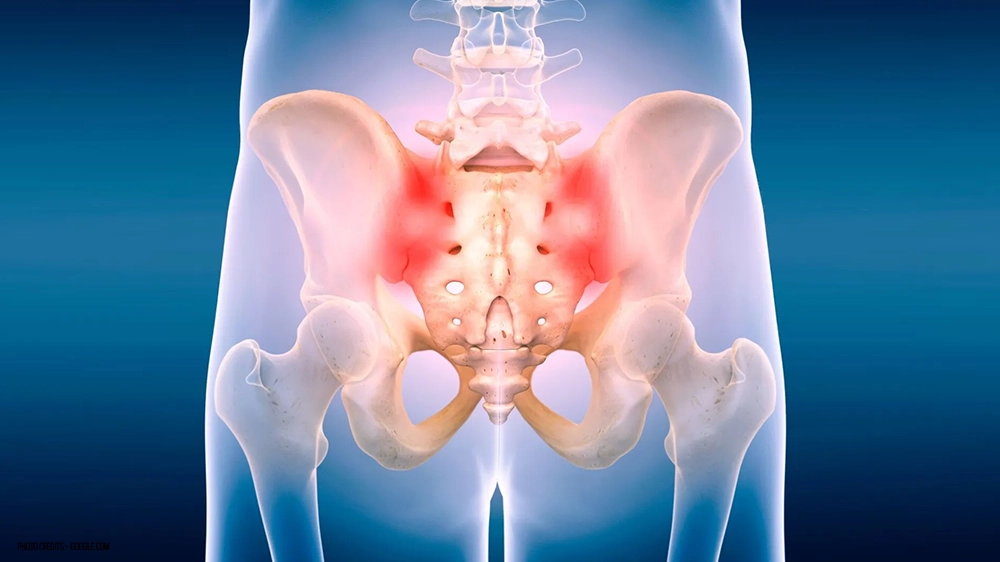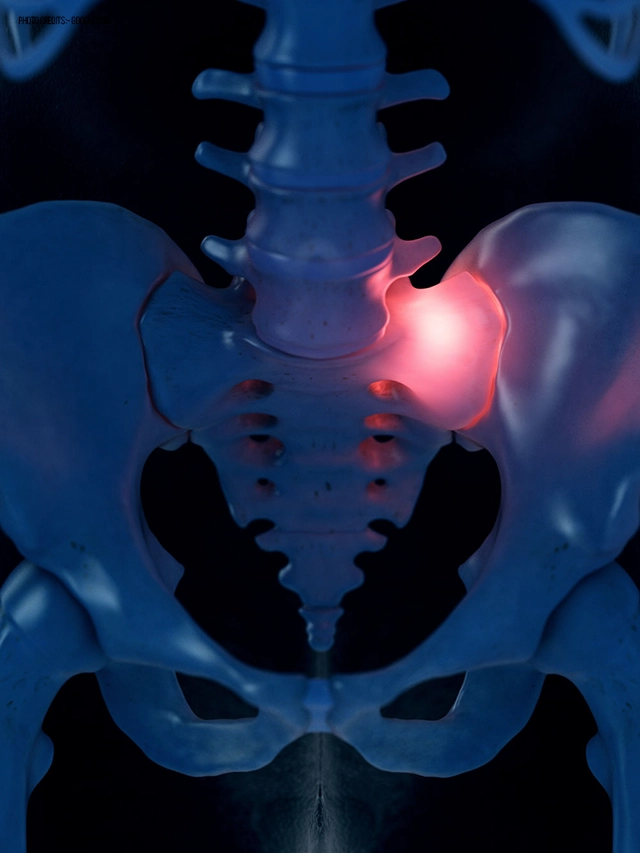
HEALTH BLOG
What Causes Sacroiliac Joint Pain?
-
Rahul Priydarss
Discover what causes sacroiliac joint pain with this comprehensive guide covering injury, arthritis, pregnancy, poor posture, and overuse. Learn how trauma, hormonal changes, lifestyle habits, and degenerative conditions impact the SI joints, leading to discomfort in the lower back, pelvis, and hips. Explore effective strategies for identifying symptoms, managing pain, and preventing long-term dysfunction. Whether you’re dealing with chronic pain or occasional flare-ups, this article offers expert insights to help you find relief and restore mobility. Understand the root causes and get actionable tips to improve your joint health and overall well-being.
Introduction to What Causes Sacroiliac Joint Pain:
The sacroiliac joints (SI joints) are vital components in stabilizing the pelvis and spine, but they can also be a significant source of lower back and hip pain. These two joints, located at the back of the pelvis on either side of the sacrum, connect the sacrum to the iliac bones. They are responsible for supporting the upper body’s weight, absorbing shock during movement, and ensuring smooth pelvic motion. Although these joints have limited mobility, dysfunction can lead to sharp or dull pain in the lower back, buttocks, hips, or even down the legs.
Sacroiliac joint pain is often challenging to diagnose because its symptoms overlap with other conditions like sciatica, lumbar spine disorders, or hip problems. Understanding the underlying causes is crucial, as untreated SI joint dysfunction can limit mobility, disrupt daily activities, and impact quality of life. This guide explores the leading causes of sacroiliac joint pain, providing insights into how lifestyle, injuries, arthritis, and other factors contribute to the condition.
What is Sacroiliac Joint Pain:
Sacroiliac joint pain refers to discomfort or inflammation originating from the sacroiliac (SI) joints, located where the lower spine meets the pelvis. These joints connect the sacrum, the triangular bone at the base of the spine, to the iliac bones of the pelvis. They play a crucial role in stabilizing the body, absorbing shock, and transferring weight between the upper body and the legs.
When these joints become irritated or dysfunctional, pain can develop in the lower back, buttocks, hips, or even radiate down the legs, mimicking symptoms of sciatica. The pain can be acute (short-term) or chronic (long-term), depending on the cause. It is often aggravated by activities like sitting for long periods, standing, climbing stairs, or lifting heavy objects.

Table of Contents
Injury and Trauma to the Sacroiliac Joint:
One of the most direct causes of sacroiliac joint pain is injury or trauma to the pelvis or lower back. Accidents, falls, and high-impact sports injuries can cause sudden dysfunction in the SI joint. Trauma to the pelvis can lead to joint misalignment, tearing of ligaments, or inflammation, which triggers pain and restricts mobility.
Impact-related trauma: Car accidents and falls are common sources of sacroiliac joint injuries. When the joint becomes misaligned due to forceful impact, the surrounding ligaments may also stretch or tear, leading to instability.
Sports injuries: Athletes participating in contact sports like football or rugby are at higher risk of SI joint pain due to repetitive stress on the pelvis. Similarly, runners may experience trauma from repetitive pounding on hard surfaces, resulting in inflammation of the joint.
Microtraumas: Even if there is no single traumatic event, repeated strain—such as lifting heavy objects or improper bending—can gradually damage the joint, causing pain over time. Without treatment, these microtraumas may worsen and cause chronic dysfunction.
Overuse, Repetitive Strain, and Postural Imbalances:
Overuse injuries occur when the sacroiliac joints are subjected to prolonged stress through repetitive activities or poor body mechanics. Over time, improper movements or excessive pressure on the joints can result in pain and stiffness.
Repetitive movements: Individuals whose jobs require frequent lifting, twisting, or bending—such as construction workers or nurses—may develop SI joint pain. These activities can strain the ligaments supporting the joint, leading to inflammation.
Postural imbalances: Sitting or standing with poor posture for long periods causes the pelvis to tilt abnormally, creating uneven pressure on the SI joints. For instance, sitting slouched or standing with weight shifted to one leg increases the strain on the joints. Over time, this can lead to dysfunction and pain.
Leg length discrepancy: Even slight differences in leg length can alter the alignment of the pelvis and put additional stress on one sacroiliac joint. This imbalance can lead to chronic pain if not properly addressed.
Pregnancy and Hormonal Changes:
Pregnancy places significant strain on the pelvis, making sacroiliac joint pain a common issue among pregnant women. The hormone relaxin plays a critical role in preparing the body for childbirth by loosening ligaments, including those supporting the SI joints. While this increased flexibility helps the pelvis expand during labor, it can also destabilize the joints, resulting in pain.
Postural changes: As the baby grows, a pregnant woman’s center of gravity shifts, causing her posture to change. This change increases the load on the sacroiliac joints and may result in discomfort in the lower back and hips.
Weight gain: The additional weight carried during pregnancy puts extra pressure on the pelvis, contributing to joint pain. Women often experience SI joint dysfunction in the third trimester as the pelvis widens and the baby drops lower.
Postpartum issues: After childbirth, some women continue to experience pain due to lingering instability in the sacroiliac joints. Recovery can take time, and without proper rehabilitation, this pain may persist long after delivery.
Arthritis and Degenerative Conditions:
Arthritis is another major cause of sacroiliac joint pain. In particular, osteoarthritis and ankylosing spondylitis are two conditions that frequently affect these joints.
Osteoarthritis: As people age, the cartilage that cushions the sacroiliac joints wears down, causing friction between the bones. This degeneration leads to pain, stiffness, and inflammation, especially in individuals over the age of 50.
Ankylosing spondylitis: This chronic inflammatory condition primarily affects the spine and sacroiliac joints. Over time, it can cause the joints to fuse, resulting in limited mobility and significant discomfort. Early signs of ankylosing spondylitis include morning stiffness and lower back pain that improves with movement.
Rheumatoid arthritis: This autoimmune disorder causes widespread joint inflammation, including in the SI joints. In some cases, rheumatoid arthritis leads to sacroiliitis—an inflammation of the sacroiliac joints—which can cause severe pain and stiffness.

Poor Body Mechanics and Muscle Imbalance:
Weak or tight muscles can indirectly affect the sacroiliac joints by disrupting the natural alignment of the pelvis. For example:
Weak core muscles: If the abdominal and gluteal muscles are weak, they cannot adequately support the pelvis and lower back. As a result, the sacroiliac joints may bear more weight than they are designed to handle, leading to pain and dysfunction.
Tight hip flexors or hamstrings: Tight muscles around the pelvis can pull the sacrum out of alignment, increasing the stress on the SI joints. Stretching these muscles regularly can help maintain proper alignment and prevent pain.
Improper lifting techniques: Lifting heavy objects without engaging the core muscles can strain the sacroiliac joints. Over time, this repetitive strain can lead to chronic pain and joint dysfunction.
Infections and Inflammatory Conditions:
Although rare, infections can cause sacroiliac joint pain. Sacroiliitis, the inflammation of the sacroiliac joint, may occur due to bacterial infections that spread through the bloodstream. Individuals with compromised immune systems or those who have recently undergone surgery are at higher risk.
Symptoms of infection: Signs of an infected SI joint include swelling, redness, fever, and localized pain. Immediate medical intervention is necessary to prevent the infection from spreading.
Systemic inflammation: Inflammatory conditions such as lupus or psoriasis can also affect the sacroiliac joints. These autoimmune diseases cause the body to attack its own tissues, resulting in joint inflammation and pain.
Lifestyle Factors and Risk Groups:
Several lifestyle habits and physical characteristics increase the likelihood of developing sacroiliac joint pain.
Obesity: Excess weight places extra stress on the sacroiliac joints, making them more susceptible to pain and dysfunction. Maintaining a healthy weight can reduce this risk.
Sedentary lifestyle: People who spend most of their day sitting are more prone to SI joint pain because prolonged sitting can weaken the muscles that support the pelvis. Regular exercise and stretching can help prevent these issues.
High-impact activities: Athletes and individuals with physically demanding jobs are at greater risk of developing SI joint pain due to repetitive stress and overuse injuries.
Medicines for Sacroiliac Joint Pain:
Managing sacroiliac joint (SI) pain often involves medications to reduce inflammation, relieve discomfort, and improve mobility. Here are some commonly recommended medicines:
- Non-Steroidal Anti-Inflammatory Drugs (NSAIDs):
- Examples: Ibuprofen (Advil), Naproxen (Aleve)
- NSAIDs help reduce inflammation and alleviate pain. They are often the first-line treatment for mild to moderate SI joint pain.
- Pain Relievers (Analgesics):
- Examples: Acetaminophen (Tylenol)
- These relieve pain without addressing inflammation and are suitable for individuals with mild pain or those who cannot take NSAIDs.
- Muscle Relaxants:
- Examples: Cyclobenzaprine, Baclofen
- Muscle relaxants can reduce muscle spasms associated with SI joint dysfunction, providing additional pain relief.
- Corticosteroid Injections:
- Cortisone injections directly into the SI joint can offer significant pain relief by reducing inflammation. This option is usually recommended when oral medications are not effective.
- Antidepressants and Neuropathic Pain Medication:
- Examples: Duloxetine (Cymbalta), Gabapentin (Neurontin)
- If nerve-related pain occurs, these medications help manage chronic discomfort and improve quality of life.
FAQs about What Causes Sacroiliac Joint Pain:
A1: The primary causes include injury, arthritis, pregnancy, poor posture, overuse, and muscle imbalances. Trauma or repetitive strain can also trigger SI joint dysfunction.
A2: Yes, sitting or standing with improper posture places uneven pressure on the SI joints, leading to pain and misalignment over time.
A3: Hormonal changes and weight gain during pregnancy can loosen the SI joint ligaments, causing instability and discomfort.
A4: Yes, conditions like osteoarthritis and ankylosing spondylitis can cause inflammation or degeneration in the SI joints, resulting in chronic pain.
A5: Obesity, sedentary habits, and high-impact activities can increase stress on the SI joints, making pain and dysfunction more likely.

-Please remember, to always consult with healthcare professionals or Doctors for personalised advice related to medical conditions.
Conclusion:
Sacroiliac joint pain is caused by a variety of factors, including trauma, overuse, arthritis, pregnancy, and lifestyle habits. Identifying the underlying cause is essential for effective treatment and long-term management. Whether triggered by injury, hormonal changes, or poor posture, addressing these issues through physical therapy, exercises, posture correction, or medical intervention can alleviate pain and restore mobility. With the right care, most people can manage their SI joint pain and return to their normal activities.




